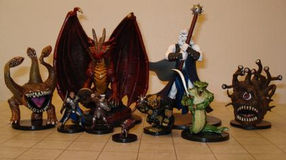Gamestorming #9: Physical Prototyping
- Caity Kelly
- Apr 5, 2019
- 2 min read

Out of all the different types of prototyping we have studied in my Learning Game Design class, my favorite method so far is the physical prototype. Books such as "Game Design Workshop: A Playcentric Approach to Creating Innovative Games" by Tracey Fullerton offer excellent strategies for creating prototypes for most any game--including complex video games. Compared to other methods, physical prototypes are simple, cost-effective, and can be understood by individuals regardless of their level of software expertise.
For my game design purposes, the physical prototype is ideal because my particular game uses physical pieces. Using tactile pieces in this phase of the game design has several advantages including the following:
Deciding sizes for different pieces relative to one another
Designs for each game piece (cards, box cover, instructional booklet)
Organization of text/visual elements on the cards
Color schemes/aesthetic designs
In the prototype phase, I am able to use materials such as simple cardboard, colored paper, markers, and other affordable items. This is important for avoiding wasting nicer materials that should be used for final drafts of the game.
During earlier phases of my game design I also used digital methods such as PowerPoint to create preliminary concept work for my game. This has been an incredibly helpful tool for deciding on early card designs and mapping out the flow of different game actions. Although pencil and paper can work perfectly well for this area of planning, I found that PowerPoint was particularly helpful due to its selections of icons that I could use to symbolizes portions of the game. Additionally, I was able to paste the image of the box cover directly onto the slide, which was helpful to see when making other gameplay decisions.
My favorite aspect of physical prototypes is the the level of creativity that can be achieved with them. There is no need for much refinement of perfection in whatever items are used for this process, which allows the designer to fully flex his/her creativity. Consider writing first drafts of a paper. There is little heed paid to details such as spelling, grammar, or sentence structure. The goal is to pour out ideas without much thought to other details that could distract the writer away from his-her focus. In a way, the physical prototype is similar as it allows the creator to throw out ideas to see if they work without too much focus on polishing the details. Consider the example below:

This designer used simple clay to create game piece prototypes. Due to the color options and malleable nature of clay, I think this is a great tool. For my own prototype, I intend to use a set of "build your own game" cards I found at a book store. They will be incredibly helpful for allowing me to work on the design of the cards and placement of the text.


Comments